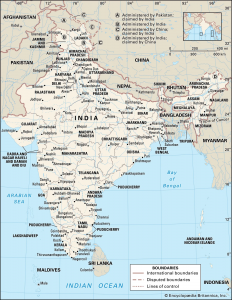India, country that occupies the greater part of South Asia. Its capital is New Delhi, built in the 20th century just south of the historic hub of Old Delhi to serve as India’s administrative centre. Its government is a constitutional republic that represents a highly diverse population consisting of thousands of ethnic groups and likely hundreds of languages. With roughly one-sixth of the world’s total population, India is the second most populous country, after China. 
It is known from archaeological evidence that a highly sophisticated urbanized culture—the Indus civilization—dominated the northwestern part of the subcontinent from about 2600 to 2000 BCE. From that period on, India functioned as a virtually self-contained political and cultural arena, which gave rise to a distinctive tradition that was associated primarily with Hinduism, the roots of which can largely be traced to the Indus civilization. Other religions, notably Buddhism and Jainism, originated in India—though their presence there is now quite small—and throughout the centuries residents of the subcontinent developed a rich intellectual life in such fields as mathematics, astronomy, architecture, literature, music, and the fine arts.
India is considered the world’s largest democracy. As the historic geography and the development patterns of India are examined, the complexities of this Hindu state surface. European colonizers of South Asia included the Dutch, Portuguese, French, and, finally, the British. In search of raw materials, cheap labor, and expanding markets, Europeans used their advancements in technology to take over and dominate the regional industrial base. The East India Company was a base of British operations in South Asia and evolved to become the administrative government of the region by 1857. The British government created an administrative structure to govern South Asia. Their centralized government in India employed many Sikhs in positions of the administration to help rule over the largely Muslim and Hindu population. The English language was introduced as a lingua franca for the colonies.
In truth, colonialism did more than establish the current boundaries of South Asia. Besides bringing the region under one central government and providing a lingua franca, India’s colonizers developed the main port cities of Bombay, Calcutta, and Madras (now called Mumbai, Kolkata, and Chennai, respectively. The names of the port cities have been reverted to their original Hindi forms). The port cities were access points for connecting goods with markets between India and Europe. Mumbai became the largest city and the economic center of India. In 1912, to exploit the interior of India, the British moved their colonial capital from Kolkata, which was the port for the densely populated Ganges River basin, to New Delhi. Chennai was a port access to southern India and the core of the Dravidian ethnic south.
Britain exploited India by extending railroad lines from the three main port cities into the hinterlands, to transport materials from the interior back to the port for export. The Indian Railroad is one of the largest rail networks on Earth. The problem with colonial railroads was that they did not necessarily connect cities with other cities. The British colonizers connected rail lines between the hinterland and the ports for resource exploitation and export of commercial goods. Today, the same port cities act as focal points for the import/export activity of globalization and remain core industrial centers for South Asia. They are now well connected with the other cities of India.
Goa is the smallest state of modern-day India. In the sixteenth century, it was first encountered by Portuguese traders, who annexed it shortly thereafter to become a colony of Portugal, which it was for the next 450 years. Goa was one of the longest-held colonial possessions in the world, and was not annexed by India until 1961. By the mid-1800s, most of the population of this tiny area had been forcibly converted to Christianity. Although many Hindu traditions survived the colonial period, and Hindu holidays are celebrated here, Goa is known for its Christian holiday celebrations, especially Christmas and Easter. The cathedral and secular architecture in many of the historic buildings of Goa are European in style, reflecting its Portuguese origins.
